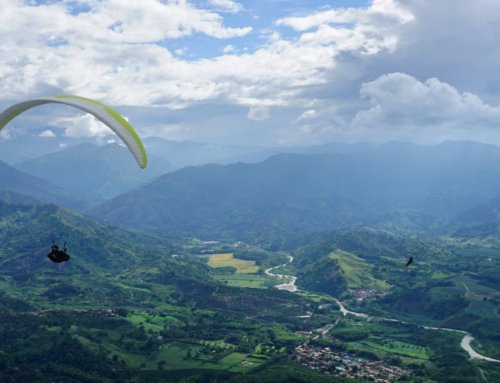We all know that the less porous our canopy fabric is, the better. It is important that our wing stays pressurised, and cloth that leaks air will reduce that pressure. But is it equally important all over the wing, on the bottom and on the top surface?
The proper maintenance of the shape of our wing is important for reasons of performance and safety. The shape is determined not just by the dimensions of the lines and cut of the canopy, but also by the airflow around and pressure within the wing. If the internal pressure is not sufficient, the wing shape will alter and become relatively soft, making it more prone to, for example, collapse.
When it is first woven, ripstop fabric is highly porous. Subsequent processing involves heat and pressure, which changes the physical properties of the cloth, and then a resin is applied to complete the transformation. These processes typically change the round cross section of the filaments to a flattened oval shape, and the resin coating fills almost all of the remaining gaps between filaments. Through mechanical wear and tear, at a microscopic level, the filaments can revert towards their original cross section, and the coating can begin to break down, increasing the porosity of the cloth.
A service workshop can test the porosity of the fabric with a meter that measures how long it takes for a fixed volume of air to pass through: a longer period of time indicates that the porosity is low, which is good, and conversely, a shorter period is not. Most manufacturers set a minimum time below which a wing is no longer considered safe to fly. Whilst the minimum figure can vary between manufacturers, at Aerofix we will measure porosity much more extensively across the wing if we get any readings below 20 seconds.
One manufacturer only sets porosity requirements for the upper surface: through testing they established that wings with an average porosity meter reading of less than a second were safe to fly, so they decided to remove testing requirements for the lower surface entirely. That intrigued me: why would the porosity of the lower surface matter less? Reflecting on the way wings generate lift, I knew that lift was a result of lower pressure above the wing, so I could see that the pressure difference across the top surface fabric would be much greater than across the bottom.
I was reading Ozone’s paper about their sharknose design and I came across a diagram that illustrates why the top surface matters more (labelled Figure 4). On this diagram, the pressure at the surface of the wing is shown: the red area shows where the pressure is higher than the internal pressure, and blue is lower. The difference in pressure is represented by the length of the line drawn from the surface of the wing. You can see that these lines are much longer in the blue area towards the leading edge of the wing, particularly on the first third of the upper surface, and relatively short elsewhere. These longer lines show that the pressure is lowest shortly behind the leading edge on the top surface, which is where the lift generated will be the greatest. The diagram illustrates that most lift is generated towards the front, and as a consequence, why most of our weight is carried on the As and Bs.
I’d also like to discuss why the pressure difference is greatest towards the front of the wing, but I’ll have to return to that in a later article. But for now, it’s enough to recognise that the diagram shows us that it is in this forward area of the top surface that the porosity of the fabric is most important. This is the part of the wing on which porosity testing is focussed, and is also the area of our wings of which we should probably take particular care.
How to help avoid your wing becoming porous early
Heat and damp, or even worse, a combination of the two, are enemies of paraglider fabric. UV and abrasion will also accelerate the deterioration of the canopy. Allowing salt water to dry and form crystals within the cloth will break down the coating and shorten the life of your wing. If you want to maximise the longevity of your glider, then:
- Make sure your glider is dry when you pack it away – and if that’s not possible immediately, then open it out again as soon as possible afterwards to allow it to dry out.
- Avoid baking your glider in a hot car or lying out in strong sunlight.
- Dragging your wing across concrete, rocks or sandy ground really shouldn’t be done.
- If you do fly dunes or land on a beach (which are best avoided for a long glider life), afterwards try to get as much sand out as you can.
- Gently rinse your glider in fresh water before it dries out after a dunk in the sea.
- Keep paramotor fuel and oil as far away from your wing as you possibly can.
- Fold your glider fairly loosely before finally folding it up and packing it into your rucksack. It’s OK to pack it away fairly tightly as long as when you were folding it, you thought about trying to minimise the stresses in the fabric, particularly towards the leading edge.
- If you’re not going to be flying for some time, release the compression strap on your rucksack and give your wing a bit more space to relax!
If you to chat anything through, we’re always happy to offer help and advice over the phone (01433 627195) or by email (info@aerofix.com).

